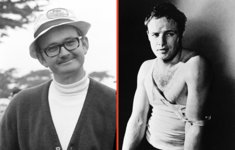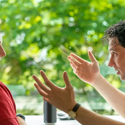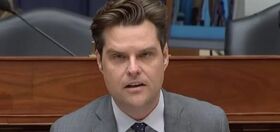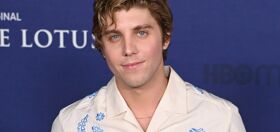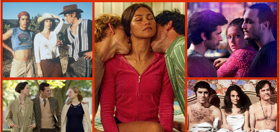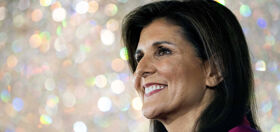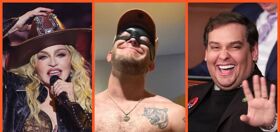Coinciding with the April 3 centennial of an undisputed American legend is the new book, “Marlon Brando: Hollywood Rebel.” The revelatory biography by author, journalist, and pop culture authority Burt Kearns digs deep into unexplored aspects of Brando’s career, interests, and personality, revealing how his roles on stage and screen, combined with his wild and restless personal life, helped to transform popular culture and society. In short: how the greatest actor of the twentieth century helped lead the world into the twenty-first. In this excerpt, the author explores how Brando helped liberalize and “loosen up” attitudes toward sex and sexuality.

It has been acknowledged by Brando himself that he was very comfortable having sexual relations with men as well as women, and sometimes with men and women together. In Brando: The Biography, Peter Manso listed no less than sixteen index entries under “Brando, Marlon, Jr. (‘Bud’): bisexuality of,” with witness testimony dating back to his school days at the Shattuck Military Academy, where he had an open relationship with a fellow cadet, who “was several years younger than Marlon, finely featured to the point of almost being pretty.”
How about we take this to the next level?
Subscribe to our newsletter for a refreshing cocktail (or mocktail) of LGBTQ+ entertainment and pop culture, served up with a side of eye-candy.
Truman Capote interviewed Brando in Kyoto, Japan, during the filming of Sayonara, for what would be an uncomfortably revealing piece in The New Yorker. During their conversation, Capote mentioned a mutual friend who claimed he’d had sex with the actor. “I asked Marlon and he admitted it,” Capote told his biographer Gerald Clarke. “He said he went to bed with lots of other men, too, but that he didn’t consider himself a homosexual. He said they were all so attracted to him: ‘I just thought I was doing them a favor.’” Brando told a French magazine in 1976, “Like a large number of men, I, too, have had homosexual experiences and I am not ashamed.” There were more questions and Brandoesque mumbles about Brando’s sexuality when he appeared, for no explained reason, in drag in the 1976 western, The Missouri Breaks. “I’ve never paid attention to what people said about me,” he said. “Deep down I feel ambiguous, and I’m not saying that to spite the seven out of ten women who consider me, wrongly perhaps, a sex symbol. According to me, sex is something that lacks precision. Let’s say sex is sexless.”
At that time, he added, “Homosexuality is so much in fashion, it no longer makes news.” His revelation did make news—as did his Last Tango costar Maria Schneider’s comment a few years earlier that one thing she and Brando had in common was their bisexuality. (“He said, ‘Let’s go for a walk,’” Schneider told Judy Klemesrud of the New York Times of her first meeting with Brando. “Then he said, ‘Maria, you’re going to have to put your finger up my rear, so let’s get to know each other.’”)
There were his relationships with the writer James Baldwin, the French actor and director Christian Marquand (for whom Brando named his son in 1958, and in whose film, Candy, Brando appeared ten years later), and most controversially, his oldest friend, Wally Cox. Brando and Cox were both born in 1924 and had known each other since they were nine years old. “Wally Cox wasn’t really my friend. He was my brother, closer to me than any human being in my life except my sisters,” Brando said, and while Cox was known to have preferred women, there’s speculation that Cox stepped into some of the anything-goes orgies Brando favored in his days on Broadway. It was at Brando’s suggestion that Cox became comfortable with his interest in sadomasochism. “Get it out in the open. People like all sorts of things,” Brando said he told his pal. He gave Cox the confidence, according to Brando biographer William J. Mann, to facilitate his interests by setting up a trapeze (in front of a mirror) in his apartment. “He’d dress up in boots and have girls whip him. They would make him grovel, and it made him sexually happy,” Brando told Robert Lindsey in the original interviews for Songs My Mother Taught Me.
When it comes to Brando’s comfort with his sexual fluidity and its prominence in The Wild One, it may be only coincidence that months before he returned to Hollywood from New York to begin filming in February 1953, he was featured in another picture that remained underground for more than fifty years—until the Internet made it available to anyone who could Google it.
It is a photograph of Brando with his lips wrapped around an erect penis. The member was said to belong to Wally Cox, although its ownership has been subject to great debate. The picture had been talked about in show business circles for decades. Kenneth Anger, the imaginative author of Hollywood Babylon, told an interviewer that he possessed a copy and for years was unsuccessful in his attempts to convince a publisher to print it.
In his Brando biography, Charles Higham called the picture “a vicious forged photograph” with faces “cleverly superimposed on other people’s bodies in a studio lab.” But when the picture first appeared online in 2004, and was published in 2006 in Darwin Porter’s book, Brando Unzipped, the only face shown is Brando’s, the person he is attached to is not identified, and by most all accounts, the photo is genuine. Porter wrote that the picture was taken at a celebrity party in Harlem thrown by Phil Black, a female impersonator well known for sponsoring the Harlem “fancy dress” drag queen balls that attracted the literati and Hollywood stars, and inspired the Voguing Balls that began in the 1970s (and inspired Madonna’s number 1 single, “Vogue”—a song that namechecked Marlon Brando). Black supposedly dared Brando to take the photo. Porter quoted actor Tom Ewell as saying that “Wally went along with it.” Whoever went along was certainly “up” for it. Porter writes that within weeks, the photograph was in wide circulation on both coasts. Roddy McDowell told Porter that he “found the picture being sold openly at kiosks along the Seine” in Paris. Further proof of its legitimacy was a snapshot that showed a framed print of the photo in the living room of French artists Pierre et Gilles.
According to Porter, Brando’s first wife, Anna Kashfi, intended to show the photo in court, as evidence of his “perversity,” in the bitter divorce and child custody fight that began in 1959. “Later, Marlon admitted to friends that he did indeed pose for the photograph, but dismissed it, saying, ‘It was only done as a joke at a party. It’s not to be taken seriously.’”
Brando’s nonchalance at what was at the time, and would be today, a very scandalous photo of an A-list leading man, was the foundation beneath the quiet sexual revolution that he pioneered, himself. Twenty years later, Brando instructs Maria Schneider to penetrate him anally in Last Tango in Paris, an activity that supported Swedish director Ingmar Bergman’s contention that Last Tango was “not really about a middle-aged man and a young girl, but about homosexuals.” Armond White agreed that the “foolishly guilt-free sexcapades” between the characters Paul and Jeanne “undeniably resembled the libertine exploits that gay men enjoyed pre-AIDS.” The quick, anonymous “hook-ups” also foreshadowed twenty-first-century dating apps like Tinder, Grindr, and AdultFriendFinder.
With the exception of a scene in which he “moons” a room full of tango dancers, Brando offers no explicit nudity in Last Tango. The one “full- frontal” nude scene he had been scheduled to perform led, he said, to “one of the more embarrassing experiences of my professional life. . . . It was such a cold day that my penis shrank to the size of a peanut.”
“I realized I couldn’t play the scene this way, so I paced back and forth around the apartment stark naked, hoping for magic. . . . I concentrated on my private parts, trying to will my penis and testicles to grow; I even spoke to them. But my mind failed me. . . . I simply couldn’t play the scene that way, so it was cut.”
The issue of Brando’s sexuality resurfaced unexpectedly in February 2018, in an interview with music producer Quincy Jones that was posted on New York magazine’s pop culture website, Vulture. “Brando used to go cha-cha dancing with us,” Jones, then eighty-four, said of his longtime friend. “He could dance his ass off. He was the most charming motherfucker you ever met. He’d fuck anything. Anything! He’d fuck a mailbox. James Baldwin. Richard Pryor. Marvin Gaye.”
“He slept with them?” interviewer David Marchese asked. “How do you know that?”
Jones, Marchese reported, frowned. “Come on, man. He did not give a fuck!”
For some reason, revelations about the mailbox, Baldwin, and Gaye slipped under the pop culture radar, but mention of sex with the legendary comedian Richard Pryor spread across the Internet and made news around the world (as well as providing material for months of comedic reenactments by comedian Gilbert Gottfried on his popular podcast). Pryor’s widow, Jennifer, basically confirmed the story. “It was the seventies,” she said. “Drugs were still good, especially quaaludes. If you did enough cocaine, you’d fuck a radiator and send it flowers in the morning.” Speaking on behalf of Brando’s survivors, his son Miko expressed disappointment “that anyone would make such a wrongful comment about either Marlon Brando or Richard Pryor.”
From Chapter 11 of “Marlon Brando: Hollywood Rebel“ by Burt Kearns, published April 2024 by Applause Theatre & Cinema Books. Available now wherever books are sold, online and in stores, with signed copies at LarryEdmunds.com.
Related:
Marlon Brando and the Old Hollywood art of going down on one’s best male friend
Marlon Brando and Wally Cox were unlikely friends.

